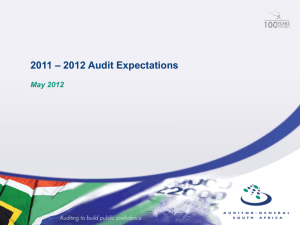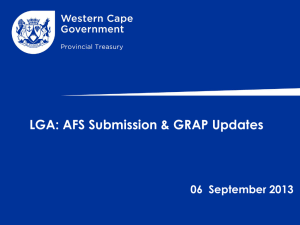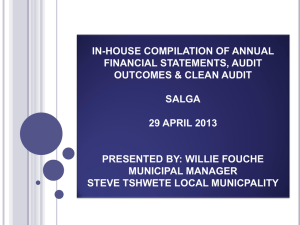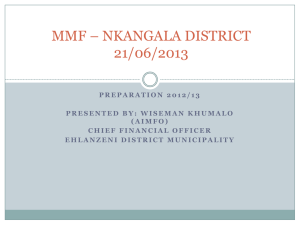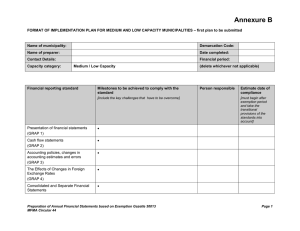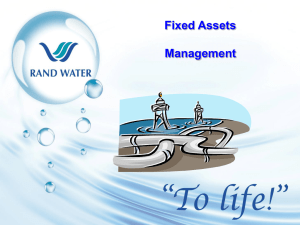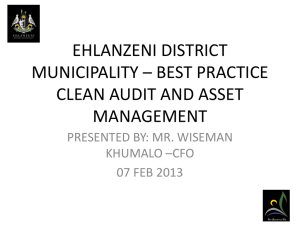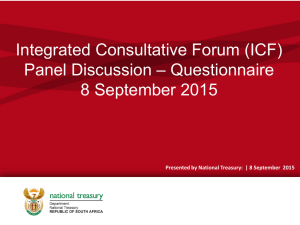06. ICF Durban_Draft Position Papers_09 Sept_2015
advertisement
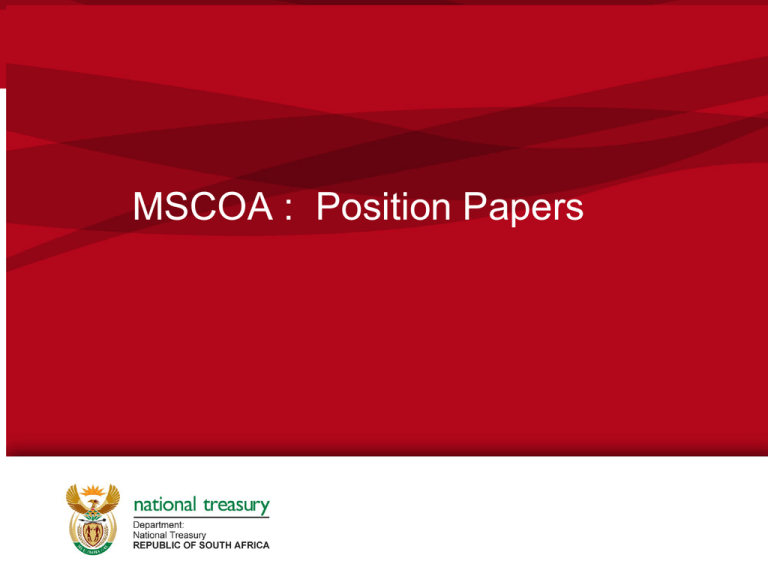
MSCOA : Position Papers Outline: Background Objectives Position papers Debtors Free Basic Services Funds and Reserves Subsidies and Transfers Water Balance Reporting Reclassifications Way forward Background Principles defined in the mSCOA Design Framework: Central point of access for all local government information Improved data quality and integrity Uniform classification framework Standardised through the classification framework Supported by a modernised system application GRAP reporting in the context of mSCOA: Annual Financial Statements presented to Council, Provincial Legislatures, Parliament and other stakeholders Budgeting framework in terms of National Treasury Legislative framework Objective MSCOA framework, GRAP framework & Budget Framework Platform to debate transversal issues Consensus on issues between all stakeholders including National Treasury mSCOA, Accountant-General, Auditor-General, ASB, NERSA, DWA and most importantly Municipalities Consistent application of matters affecting MSCOA Discussion Papers= subject matter driven linking MSCOA to phase 1 existing reporting format & phase 2 future reporting Position Papers= authoritative guidance on specific issues related to MSCOA Not replacing legislation, circulars, NT guidelines, practice notes or implementation guidelines- i.e, these prevail 4 Debtors Impairment of debtors in terms of GRAP 104/ GRAP 108 Impairment allowances Debts written off in terms of Council Resolution Inconsistent application of the write off Utilisation of provision or Statement of financial performance Draft position Debt write off to be expensed to statement of financial performance Assessment of impairment allowance to be performed annually from an AFS perspective 5 Cost of Free Basic Services Cost of Free Basic Services are funded by the fiscus through the Equitable Share Funding and Cost of Free Basic Services are not disclosed in the Annual Financial Statements in terms of GRAP due to the following: Revenue recognised in terms of GRAP 23 as Non-exchange revenue through the Equitable Share Cost of Commodity included in Bulk Purchases/ Expenses Differing practices within municipalities Free Basic Services Provided constitutionally Indigent Debtors Specific Municipality rebates 6 Documents The following documents have been consulted regarding budgeting & accounting for Free Basic Services (FBS) Circular 51 – par 6.4 Revenue & Revenue Foregone Circular 58 – par 6.8 & 6.9 Cost of FBS vs Revenue Cost of Free Services GRAP 9 Revenue From Exchange Transactions GRAP 23 Revenue From Non-exchange Transactions (Taxes And Transfers) IGRAP 1 Applying The Probability Test On Initial Recognition Of Revenue FAQ on FBS - ASB website 2015 DoRA 7 Budgeting for Free Basic Services – Current Position FBS subsidised from the basic services component of the Equitable Share Basic services component of ES provides a subsidy of R313.76 per month in 2015/16 for households below the monthly household income of R2 300 for the cost of providing basic services: 6kl Water, 50 Kwh electricity, refuse removal, sanitation Subsidy as per national standard Non-cash grant SA21 => A4 Subsidy above national standard (additional subsidy) Revenue forgone – subtract on SA1 Free Basic Alternative Energy supplied to indigent households – Where electricity is not available Cash grant SA21 => A4 Free Basic Electricity to indigent households – where Eskom holds the license Payment to Eskom – Cash grant SA21 => A4 8 Budgeting for Free Basic Services – Current Position Property rates (Not FBS as per the definition of the Equitable Share Formula) Impermissible values as per MPRA Section 17 (1) of MPRA (R15 000, 30%PSI, public worship, etc.). Section 2 of Regulation on Ratio Between Residential/Non-Residential Category of Property (Government Gazette 33016, 12 March 2010) Do not levy - Not revenue forgone neither non-cash grant Higher values than impermissible values Revenue forgone – subtract on SA1 Rebate/reduction/exemption in terms of sect 15(1) of MPRA to all ratepayers of a particular category (property or owners) as defined in subsection 15(2) Revenue forgone – subtract on SA1 Rebate/reduction/exemption in terms of sect 15(1) of MPRA to some ratepayers or an individual of a particular category (property or owners) as defined in subsection 15(2) Non-cash grant SA21 => A4 9 Budgeting for Free Basic Services – Current Position Grants to Institutions Cash Grant/transfer to institution Cash grant SA21 => A4 10 Inconsistent Interpretations by Municipalities Example 1 Cost of FBS A10 close to non-cash grants on SA21 Cost of FBS = revenue cost of free services – Questionable as to what was used for determining cost ? Revenue forgone rates appears to be understated by R27.2 million FBS was expenses on cash flow SA30 & A7 - not shown as revenue foregone Revenue on cash flow possible overstatement of R 27.2 million 11 Inconsistent Interpretations by Municipalities Example 2 Cost of FBS A10 differ by R107.3 million to non-cash grants on SA21 Revenue forgone rates appears to be understated by R8.2 million FBS was not expenses on cash flow SA30 & A7 – only cash grants & transfers - understated by R3.7 million Revenue forgone for services appears to be understated by R39.6 million Revenue on cash flow possible overstatement of R 51.5 million 12 Inconsistent Interpretations by Municipalities Example 3 Cost of FBS A10 differ by R125.0 million to non-cash grants on SA21 Cost of FBS = revenue cost of free services – Questionable as to what was used for determining cost ? Revenue forgone rates appears to be understated by R8.8 million FBS was not fully expenses on cash flow SA30 & A7 Revenue forgone for services appears to be understated by R114.5 million Revenue on cash flow possible overstatement of R 123.3 million 13 Inconsistent Interpretations by Municipalities Example 4 Cost of FBS A10 differ by R13.40 million to non-cash grants on SA21 Revenue Forgone Rates appears to be overstated by R306.8 million FBS was not expenses on cash flow SA30 & A7 Revenue Forgone for services appears to be overstated by R3.0 million Revenue on cash flow possible understatement of R 309.8 million 14 GRAP Reporting Framework No definition for revenue forgone in any accounting standard GRAP 9 - Revenue From Exchange Transactions Measurement of revenue .15 Revenue shall be measured at the fair value of the consideration received or receivable. .16 The amount of revenue arising on a transaction is usually determined by agreement between the entity and the purchaser or user of the asset or service. It is measured at the fair value of the consideration received or receivable taking into account the amount of any trade discounts and volume rebates allowed by the entity. .17 In most cases, the consideration is in the form of cash or cash equivalents and the amount of revenue is the amount of cash or cash equivalents received or receivable. 15 GRAP Reporting Framework GRAP 23 Revenue From Non-exchange Transactions (Taxes And Transfers) Definitions .05 The following terms are used in this Standard with the meanings specified: Tax expenditures are preferential provisions of the tax law that provide certain taxpayers with concessions that are not available to others. .71 Taxation revenue shall not be grossed up for the amount of tax expenditures. .72 Tax expenditures are foregone revenue, not expenses, and do not give rise to inflows or outflows of resources – that is, they do not give rise to assets, liabilities, revenue or expenses of the taxing government. 16 GRAP Reporting Framework I-GRAP 1 Scope .04 This Interpretation of the Standards of GRAP addresses the manner in which an entity applies the probability test on initial recognition of: (a) exchange revenue in accordance with the Standard of GRAP on Revenue from Exchange Transactions, and (b) non-exchange revenue in accordance with the Standard of GRAP on Revenue from Non-exchange Transactions (Taxes and Transfers). .06 This Interpretation of the Standards of GRAP does not deal with: (a)…………….. (b)…………….. (c) exchange or non-exchange transactions where there is no intention to charge for all or some services. Examples include goods and services provided to indigent consumers or households or rebates deducted on the provision or acquisition of certain goods or services. 17 GRAP Reporting Framework FAQ’s on the Standards of GRAP Is revenue foregone recognised in the statement of financial performance? 1. In the public sector, entities frequently provide goods and services to consumers for free or at subsidised amounts, while rebates or similar reductions may be granted on taxes or other fees due. 2. Questions have been raised about whether these subsidies, rebates or similar reductions should be recognised as revenue. IGRAP 1 Applying the Probability Test on the Initial Recognition of Revenue, states the following: 3.This Interpretation of the Standards of GRAP does not deal with: c. exchange or non-exchange transactions where there is no intention to charge for all or some services. Examples include goods and services provided to indigent consumers or households or rebates deducted on the provision or acquisition of certain goods or services. 4. IGRAP 1 clearly only applies to those amounts that the entity intends to collect. As entities do not intend to collect the revenue related to the subsidised goods and services or other rebates, these amounts should not be recognised as revenue. 18 GRAP Reporting Framework vs Equitable Share Policy Implementation GRAP Reporting Framework Indigent subsidies for basic services, rebates or similar reductions should not be recognised as revenue – should be treated as revenue forgone This position will meet the GRAP reporting framework that Municipalities need to comply with Equitable Share Policy Implementation Equitable share not a conditional grant Structure of the local government equitable share formula - DoRA Consists of three parts, made up of five components: First part of the formula consists of the basic services component, which provides for the cost of free basic services for poor households. subsidy includes funding for the provision of free basic water (6 kilolitres per poor household per month), energy (50 kilowatt-hours per month) sanitation and refuse Reporting on policy implementation increasingly important 19 GRAP Reporting Framework vs Equitable Share Policy Implementation From policy implementing perspective Subsidies and rebates to indigent households to be disclosed separately – supporting budget schedules separate vote in the revenue section of the chart of accounts to enable data extraction for reporting “Revenue Forgone – Indigent Support” Revenue forgone other than indigent subsidies and rebates to be disclosed separately – supporting budget schedules separate vote in the revenue section of the chart of accounts to enable data extraction for reporting “Revenue Forgone – Non-Indigent Free Services” From GRAP reporting framework Net off the two “Revenue Forgone” votes against the revenue vote 20 GRAP Reporting Framework vs Equitable Share Policy Implementation - Disclosure Disclosure Without Free Basic Services to Indigent Households Gross Revenue Revenue Forgone – Non-Indigent Free Services Net Revenue - R10 000 000 R 1 000 000 R 9 000 000 Disclosure With Free Basic Services to Indigent Households Gross Revenue Revenue Forgone – Non-Indigent Free Services Revenue Forgone – Indigent Support Transfers Operational – Equitable Share Net Revenue - R10 000 000 R 1 000 000 R 2 500 000 -R 2 500 000 R 9 000 000 21 Principles All indigent accounts are billed for all services monthly Indigent tariffs should be calculated at the level of the cost of providing the service to bring the cost of the subsidy in line with the DoRA allocation Indigent accounts are then subsidised monthly passing a subsidy (credit) on the account debit “Revenue Forgone – Indigent Support” “Revenue Forgone – Indigent Support” (subsidy) will not be disclosed as a noncash transfer in the Statement of Financial Performance but will be treated as revenue foregone18 Subsidy passed on the indigent account is funded by an equal contribution from the Equitable Share “Revenue Forgone – Indigent Support” is disclosed separately on the supporting budget tables and then netting it off against gross revenue on supporting budget schedule SA1 prior to disclosing Net Budgeted Revenue on budget schedule A4 22 Funds & Reserves In terms of GRAP, reserves accounting is only allowed in the following standards GRAP 17, through the Revaluation Reserve GRAP 104 (through IAS 39) for complex financial instruments GRAP therefore requires that transactions are recorded in the Statement of Financial Performance and Statement of Financial Position GRAP does not explicitly restrict the utilisation of reserves provided that the amounts are included in the Accumulated Surplus Municipal funding and budgeting has been, and in some cases currently based on the Reserves/ Funds that the Municipalities has accumulated Risk of unfunded budget due to liquidity issues 23 Funds & Reserves The following internal funds and reserves were established in the past: Capital Replacement Reserve (CRR), Self Insurance Reserve (SIR), Capitalisation Reserve (CR), Reserve established for Compensation for occupational Injuries and Diseases (COID Reserve), Government Grant Reserve (GGR) and Donations and Public Contributions Reserve Preference of National Treasury is that the Separation of Accumulated Surplus into the Reserves should not be done Utilisation of Reserves can be utilised but only under the following circumstances: Policy for the reserve including the funding requirements if the reserve is not cash backed approved by Council At a minimum 40% of the reserve must be cash backed 24 Transfers and subsidies Generally, transfers received non-exchange transactions Subsidies provided also non-exchange Licence fees- may be either depending on the services provided and the definition of exchange vs non-exchange in GRAP 9/23 Must document the judgement in terms of GRAP 3 25 Water balance reporting Department of Water and Sanitation require information from Municipalities to manage the supply of water Water constitutes inventory in terms of GRAP 12 Differing practices throughout the country Interim position: Record the water balance in terms of GRAP 12 at year-end Calculate the water losses in terms of Circular 71 Disclose the amount of water purchased 26 Water balance reporting Final position: – Municipality must at each month end, year-end calculate the amount of Water Balance at year-end – Municipality must record the amount of Water Purchased – Municipality must calculate the Cost of Sales – Municipality must calculate the amount of Free Basic Service – Municipality must calculate the amount of losses • Amount of losses incurred due to infrastructure losses • Amount of losses incurred due to natural losses such as evaporation losses • Amount of losses due to theft or pilferage – Municipality must disclose water gains – Municipality must prepare a reconciliation 27 Comparatives and restatements Changes as a result of the application in the MSCOA results in classifications issues Consideration of Materiality Consideration whether Annual Financial Statement issue Impact of Prior Period Errors/ misstatements/ change in accounting policies/ change in estimates 28 Way forward • Draft position papers to be approved by MSCOA Project Steering Committee for comments • Comments opened to MSCOA ICF and other stakeholders • Meetings with key stakeholders including Auditor-General, ASB, Provincial Accountant-General etc.. to be conducted • All comments will be considered • Final position paper to be approved MSCOA Project Steering Committee and included on National Treasury website 29 Questions Questions
